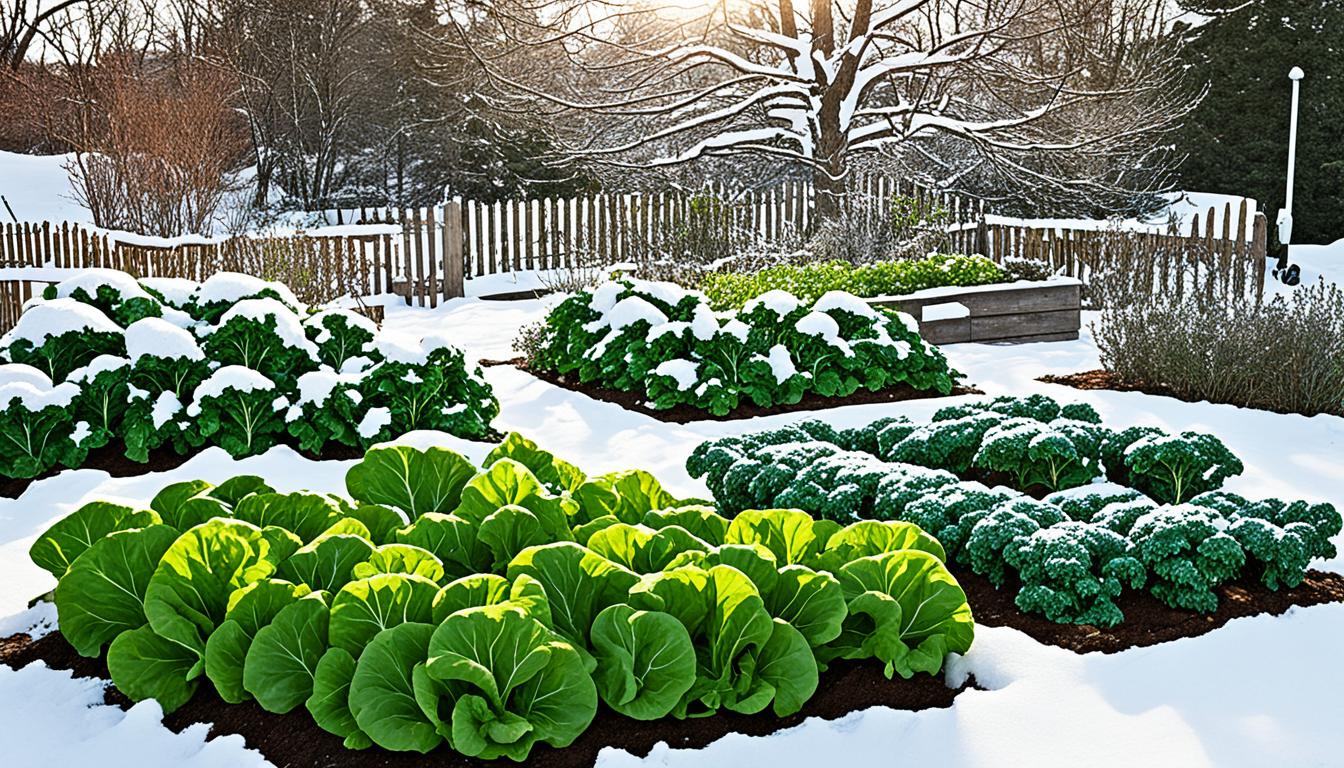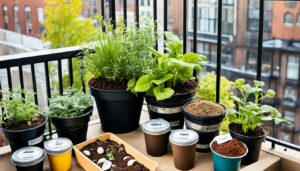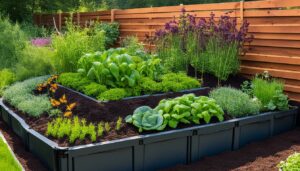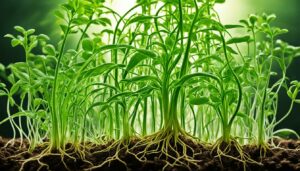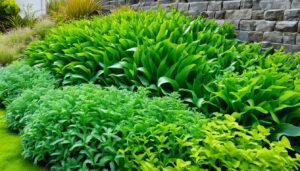While the world sleeps under a frosty blanket, a determined number of gardeners reap a surprising bounty; approximately 15% of homeowners extend their growing seasons by cultivating winter vegetable gardens. These cold-weather enthusiasts enjoy fresh produce even when the mercury dips, showcasing the resilience and adaptability of both plants and human ingenuity. This transition from summer blooms to winter greens calls for robust winter planting tips and innovative winter garden ideas. From hardy winter gardening plants to strategically planned winter vegetable gardens, the possibilities are as endless as they are enriching. Delve into the realm of four-season gardening, and unlock the secrets to cultivating a lush, winter wonderland that provides sustenance and beauty all year long.
Discovering the right techniques can transform your barren winter vista into a haven of life and growth. It’s more than just planting; it’s creating a symphony of nature that plays through every season. With proper planning and the right selection of crops, winter gardening can be more than just a pastime—it can be a lifeline to fresh, flavor-packed nourishment in the chilliest of months.
Key Takeaways
- Embrace the winter season by learning effective winter planting tips for year-round harvesting.
- Explore creative winter garden ideas that are both functional and aesthetically pleasing during colder months.
- Understand the importance of selecting the right winter gardening plants for a successful cold-weather crop.
- Discover how a well-planned winter vegetable garden can provide fresh produce even in low temperatures.
- Experience the joys of harvesting throughout the year by implementing a four-season garden approach.
- Realize the emotional well-being benefits that come with winter gardening activities.
Embracing the Cold: Benefits of Four-Season Gardening
As the autumn leaves give way to the first frosts of the season, many assume it’s time to put away their gardening tools. However, those familiar with four-season gardening know that the arrival of chilly weather marks a new chapter in the cultivation cycle. This practice presents a variety of benefits that not only promote a sustainable lifestyle but also enhance the quality of life through winter gardening benefits that are as tangible as the crisp air we breathe.
Extending Your Harvest Beyond Summer
Summer may be the peak of abundance in most gardens, but embracing the cold-weather crops associated with four-season gardening means your harvest needn’t end when the warm weather does. Vegetables like kale, Brussels sprouts, and parsnips undergo a chemical transformation in cooler temperatures, converting starches into natural sugars and yielding a sweeter taste that can be a delightful surprise on the winter table.
Efficiency in Garden Space Utilization
Gardeners often face the challenge of underutilized space in their plots as the growing season winds down. Yet, winter gardening benefits the clever use of this space. The practice of succession planting and crop rotation within a four-season framework keeps the soil active and fertile, preventing erosion and ensuring continuous productivity from the soil you’ve worked so hard to nurture.
Balanced Workload Throughout the Year
One of the most practical reasons for adopting four-season gardening is the balanced workload it offers. By staggering plantings and harvests across all seasons, garden duties are evenly distributed, alleviating the often overwhelming spring rush and autumn clear-out. This reduces stress for the gardener and ensures a steady supply of fresh produce for the table.
Winter Crops Yield Stronger Flavors and Nutritional Value
Challenging the notion that only summer’s sun can produce vibrant flavors, cold-weather crops often boast a robust nutritional profile and enhanced taste. Many leafy greens and root vegetables relish the brisk weather, packing antioxidants and vitamins essential to maintaining health during the winter months, when our bodies crave additional nutrients.
Enhancing Emotional Well-Being During Shorter Days
Finally, the psychological benefits of tending to a winter garden cannot be overstated. In the colder, darker months, the garden provides a sanctuary of greenery and growth, fostering a sense of accomplishment and peace. As a natural outlet for stress and a source of physical activity, four-season gardening is an uplifting way to enhance your quality of life throughout the entire year.
Curating Your Winter Garden: Selecting the Right Plants
An essential factor in achieving winter gardening success lies in the meticulous winter garden plant selection. This critical step involves choosing the cold-hardy comrades that will not only survive but thrive during the cooler months. Good candidates for a winter garden include a variety of cold-weather vegetable varieties like leafy greens, cruciferous vegetables, root vegetables, and hearty herbs. Each plant’s variety plays an important role, as certain cultivars possess traits better suited for shorter days and colder nights.
For example, opting for lettuce types renowned for their cold resistance ensures a steady supply of fresh greens. These varieties have been selectively bred or naturally possess qualities that enable them to grow vigorously in a climate that would spell doom for less resilient species. The right selection of plants ensures that you are not merely surviving the winter months but are effectively making them an anticipated and productive time of year in your gardening calendar.
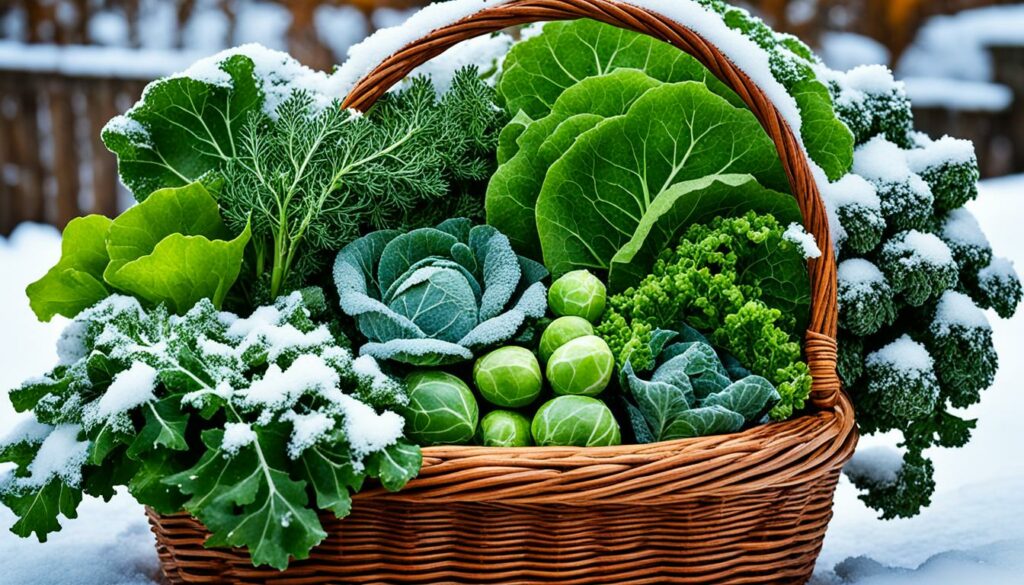
Gardeners should also be versed in the impact of diminished daylight on plant development. Daylight hours are not just about visibility; they are a cue for plants to carry out critical growth processes. Recognizing the importance of these short daylight hours empowers a gardener to plan correctly. Through intentional timing, your garden becomes a beacon of green life even as winter’s chill besets the landscape.
| Vegetable Category | Recommended Varieties | Sowing Tips |
|---|---|---|
| Leafy Greens | Kale (‘Winterbor’), Spinach (‘Giant Winter’), Collards (‘Champion’) | Sow in late summer for fall harvest; use cloches to protect from frost. |
| Cruciferous Vegetables | Broccoli (‘Waltham 29’), Brussels Sprouts (‘Long Island Improved’) | Plant in early fall; maintain even soil moisture. |
| Root Vegetables | Beets (‘Winterkeeper’), Carrots (‘Danvers’) | Direct sow before the ground freezes; mulch to protect from deep frost. |
| Herbs | Rosemary, Thyme, Parsley | Keep in pots for mobility; ensure good drainage and protection from extreme cold. |
When crafting a winter garden, balance is imperative. Not only should you consider the types of plants that can endure, but you must factor in flavor profiles, nutritional needs, and culinary versatility. A well-rounded garden should cater to your palate as much as it does to plant hardiness zones. Pairing your knowledge of plant varieties with a thoughtful approach to timing and selection will lead to a robust winter garden that delivers a variety of fresh, tasty, and nutritious options right to your dinner table.
Winter Gardening Strategies: Timing and Plant Selection
As winter approaches, understanding the timing of your garden activities can make the difference between a thriving winter harvest and one that’s less successful. Knowing how daylight in plant growth affects your plants will guide you in creating a lush winter garden. Let’s delve into specific plant selections that can help you make the most of the winter season.
The Role of Daylight in Plant Growth and Timing Your Planting
Daylight, or photoperiod, is a plant’s cue for various growth stages. During winter, the shorter days can significantly influence when and how you plant. Employing precise winter gardening timing aligns your plant’s needs with the natural light available, ensuring they don’t bolt prematurely and maximizing yield.
Leafy Greens That Flourish in the Chill
Leafy greens for winter are a delightful addition to your cold-weather garden. Varieties such as spinach, kale, and arugula are not just hardy; they also prefer the coolness, which enhances their flavor and texture. With adjusted planting schedules, these greens can produce a steady supply during the colder months.
Root Vegetables: Underground Treasures of the Winter Garden
When it comes to root vegetable harvesting, winter presents an opportunity for some of the sweetest flavors. Carrots, beets, and turnips insulated by the soil can be harvested throughout the season. Their ability to store energy in their roots makes them perfect for winter growing.
Cruciferous and Alliums: Hardy Choices for Lower Temperatures
Plants like broccoli, cauliflower, and Brussels sprouts, along with alliums such as garlic and onions, are known for their resilience. The cruciferous and allium winter growth can continue into the colder months, provided they are planted early enough to establish before frost.
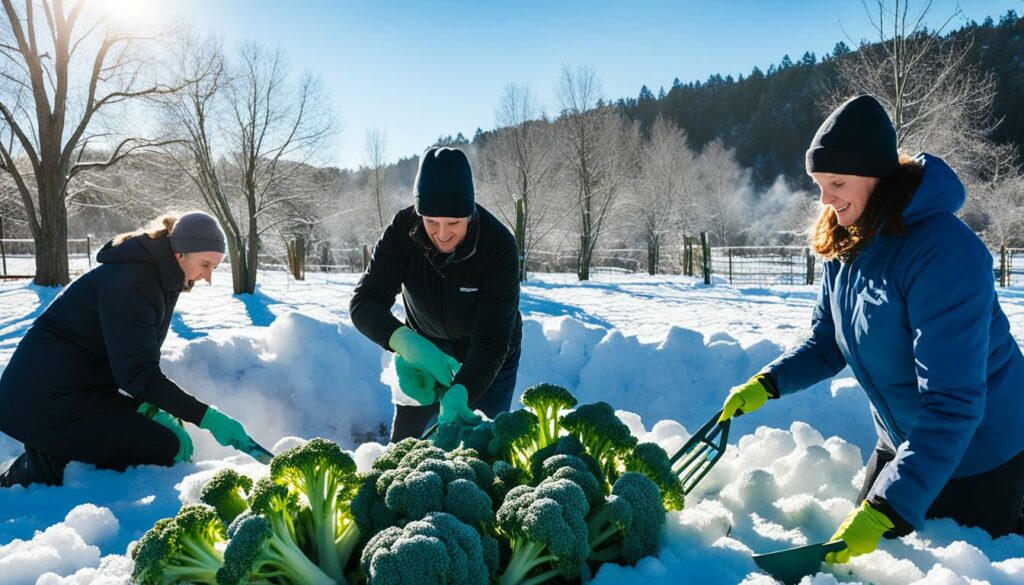
Herbs That Survive and Thrive in Winter Conditions
Many herbs are surprisingly robust despite their delicate appearances. Winter hardy herbs such as rosemary, thyme, and oregano can survive outdoor winter conditions, especially if they’re given some protection from the harshest weather. Others, like parsley and cilantro, may prefer the cover of a cold frame or greenhouse.
By choosing the right plants and understanding the impact of daylight on their growth, your winter garden can be as lively and productive as your summer one. The key is to select crops that are adapted to the season’s challenges and to time your planting schedule to align with nature’s rhythm. This strategic approach can lead to a bountiful winter harvest, bringing joy and fresh flavors to your table even in the depths of winter.
Conclusion
As the seasons shift and winter draws near, the concept of a garden that produces throughout the year transitions from a mere possibility to a sustainable lifestyle in which gardeners play a pivotal role. Sustainable winter gardening not only underscores the potential for self-sufficiency in urban and rural settings alike but also casts a spotlight on the ecological benefits of tailoring our horticultural practices to align with the natural world.
Winter Gardening as a Sustainable Choice
Adopting a four-season approach to our gardens instills the virtues of sustainability into the very essence of horticulture. With relentless foresight and careful selection of cold-hardy cultivars, the garden becomes a source of continuous harvest, even as frost adorns the once verdant lawns. It is a testament to the innovation and resourcefulness of today’s gardeners that such bounty can persist despite the chill that silences much of the natural landscape.
Year-Round Bounty: A Testament to Perseverance and Planning
Through intelligent design and scheduling, the four-season garden yields dividends that extend beyond the dinner table. Adhering to nature’s cycles with a conscious mind, practitioners of winter gardening celebrate the fruits—both literal and metaphorical—of their labors throughout the calendar year. It is through such meticulous cultivation and undying perseverance that such a harmonious system is achieved, reconciling human endeavor with the graceful ebb and flow of nature’s own rhythms.
The Joy of Harvesting in Harmony with Nature’s Cycles
In this dance with dormancy, where the earth itself seems to pause, there is profound joy found in the continuing cycle of growth and renewal. The winter garden stands as a sanctuary of life and resilience, a green refutation of the gray skies above. This dynamic balance—between the gardener’s touch and the garden’s response—demonstrates a profound respect for our ecological partners and culminates in the deep satisfaction of harvesting through winter’s lean days, rejoicing in the harmony of a well-tended four-season garden.

